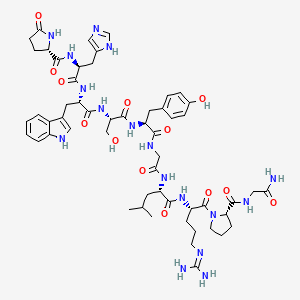Gonadorelin Information
Click here to view all Gonadorelin productsThe information, including but not limited to, text, graphics, images and other material contained on this website are for informational purposes only. No material on this site is intended to be a substitute for the consultation, diagnosis, and/or medical treatment of a qualified physician or healthcare provider.

Gonadorelin, also known as gonadotropin-releasing hormone (GnRH), is a hormone that plays a crucial role in the regulation of reproductive function. It is produced and released by the hypothalamus, a region of the brain.
Gonadorelin acts on the pituitary gland, which is located at the base of the brain. When released, it binds to specific receptors on the pituitary gland, stimulating the secretion of two important gonadotropins: luteinizing hormone (LH) and follicle-stimulating hormone (FSH).
LH and FSH are essential for the normal functioning of the reproductive system. In males, LH stimulates the production of testosterone by the testes, while FSH promotes sperm production. In females, LH triggers ovulation and the production of progesterone by the ovaries, while FSH stimulates the growth and development of ovarian follicles.
Gonadorelin can be used therapeutically to treat certain reproductive disorders. For example, in males with infertility or delayed puberty, it can be administered to stimulate the release of LH and FSH, thereby promoting the production of testosterone and sperm. In females, it can be used to induce ovulation in those undergoing fertility treatments.
Overall, Gonadorelin is a crucial hormone that regulates the release of other hormones involved in reproductive function, playing a vital role in the normal functioning of the reproductive system.
Synonyms of Gonadorelin
- GONADORELIN
- Luliberin
- 33515-09-2
- LH-Releasing factor
- Gonadorelina
- Gonadorelinum
- Luteostimulin
- Fertagyl
- Hypocrine
- Gonadotropin-releasing factor
- Gonadorelin hydrochloride
- Human gonadoliberin-i
- GnRH
- 5-oxo-PHWSYGLRPGNH2
- 9034-40-6
- Gn-RH
- Nialutin
- LH-RH
- Gonadoliberin I
- CHEBI:5520
- Mammalian GnRH
- UNII-9O7312W37G
- p-Glu-His-Trp-Ser-Tyr-Gly-Leu-Arg-Pro-Gly-NH2
- GnRH-I
- AY 24031
- LH-RF
- Glycinamide, 5-oxo-L-prolyl-L-histidyl-L-tryptophyl-L-seryl-L-tyrosylglycyl-L-leucyl-L-arginyl-L-prolyl-
- Fertagyl (TN)
- EINECS 232-895-0
- EINECS 251-553-1
- Gonadorelin (INN)
- AY 24034
- AY-24031
- 5-oxo-L-prolyl-L-histidyl-L-tryptophyl-L-seryl-L-tyrosylglycyl-L-leucyl-L-arginyl-L-prolylglycinamide
- LRF
- C55-H75-N17-O13
- Gonadorelin decapeptide
- 71447-49-9
- CHEMBL1007
- SCHEMBL143114
- [125I]-GnRH I
- GTPL3786
- DTXSID20873490
- BDBM50422274
- AKOS015895122
- AKOS030213247
- 9O7312W37G
- CCG-270650
- HS-2014
- [125I]GnRH I (human, mouse, rat)
- D08027
- pGlu-His-Trp-Ser-Tyr-Gly-Leu-Arg-Pro-GlyNH2
- A837181
- pGlu-His-Trp-Ser-Tyr-Gly-Leu-Arg-Pro-Gly-NH(2)
- Q20817116
- L-Pyroglutamyl-L-histidyl-L-tryptophyl-L-seryl-L-tyrosylglycyl-L-leucyl-L-arginyl-L-prolylglycinamide

